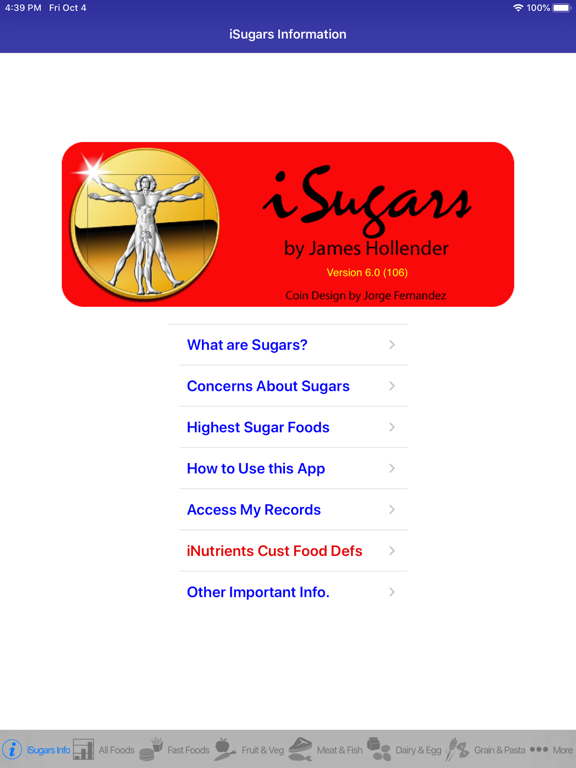
| Rating |      0.00 / 5 0.00 / 5 |
|---|---|
| Price | $2.99 |
| iTunes Link | iSugars – iNutrients: Sugars |
iSugars – iNutrients: Sugars
Description
iSugars is one of 10 iNutrient apps based on the USDA National Nutrient Database. The others include:
– iCarbs (Carbohydrates)
– iCholesterol (Dietary Cholesterol)
– iFiber (Fiber)
– iKals (Calories)
– iPotassium (Potassium)
– iProteins (Proteins)
– iSatFat (Saturated Fat)
– iSodium (Sodium)
– Vitamin K (Vitamins K1, K1D & K2)
Users can record their intake for any food. The information is maintained for one year and is presented in reverse chronological order grouped by day, so the latest data is presented first in the list. Editing allows for: 1) changing the number of servings; 2) changing the date; and 3) deleting records. Individual Intake Items can be copied to the current day, and all Intake Items for a single day can be copied to the current day.
If you are working towards healthy eating, knowing the amount of sugars in the foods available for consumption can be extremely helpful.
The iSugars app provides information about foods and how they are rated for content of sugars. This is provided as a means to assist in deciding which foods to eat. The food servings are rated from EXTREMELY LOW in sugars all the way up to EXTREMELY HIGH. The following colors help readily identify which is which:
– Black = Rated EXTREMELY HIGH in Sugars (40.01 – 166.46 g)
– Dark Red = Rated VERY HIGH in Sugars (30.01 – 40.00 g)
– Red = Rated HIGH in Sugars (20.01 – 30.0 g)
– Orange = Rated MODERATELY HIGH in Sugars (15.01 – 20.00 g)
– Yellow = Rated MODERATE in Sugars (10.01 – 15.00 g)
– Light Green = Rated MODERATELY LOW in Sugars (5.01 – 10.00 g)
– Green = Rated LOW in Sugars (1.01 – 5.00 g)
– Cyan = Rated VERY LOW in Sugars (0.01 – 1.00 g)
– White = Rated EXTREMELY LOW in Sugars (0.00 g)
Essentially, the cooler the color, the lower the amount of Sugars, with white being the coolest color and black being the hottest (think burnt).
There are eight tables listing food servings:
– All Foods
– Fast Foods
– Fruits & Vegetables
– Meat, Fish & Shellfish
– Dairy & Egg
– Cereal Grains & Pasta
– Sweets
– Snacks
The All Foods list allows you to search by any word or partial word from all the Food Titles.
Selecting a food in any of the tables will display pertinent information about the selected food serving:
– Food Title
– Weight (in grams)
– Common Measure (serving size for weight)
– Sugars Content (in grams)
– Calories
– Percentage of Sugars by Weight (if at least 1%)
– USDA Description
– USDA Food Group
– USDA Nutrient Database Number
Information is derived from the USDA National Nutrient Database for Standard Reference: Sugars Content of Selected Foods per Common Measure. There are currently over 1,100 different foods included, searchable using more than 2,500 names (some foods are known by different names or how they are prepared, e.g., “Egg, Scrambled” and “Scrambled Egg”). A few these have as many as six searchable names.
The iSugars Info screen provides access to additional information pages:
– What are Sugars?
– Concerns About Sugars
– Highest Sugar Foods
– How to Use this App
– Access My Records
– iNutrients Custom Food Definition (another app with more features and data for 10 nutrients)
– Other Important Info. (includes allowance to 1) Report a Problem; 2) Ask a Questions; and 3) Make a Suggestion)





